无机化学第十四章
- 格式:ppt
- 大小:5.25 MB
- 文档页数:66
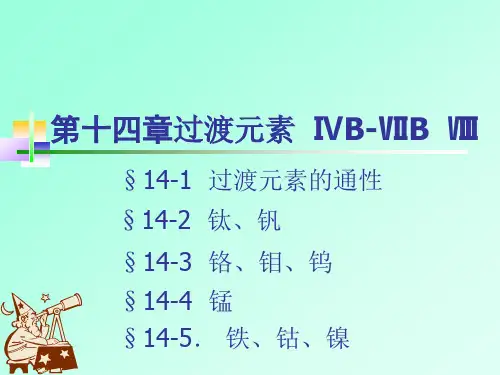
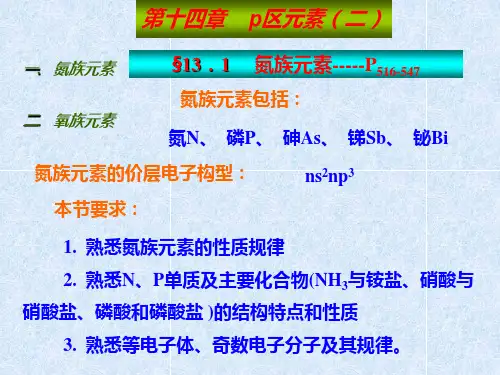
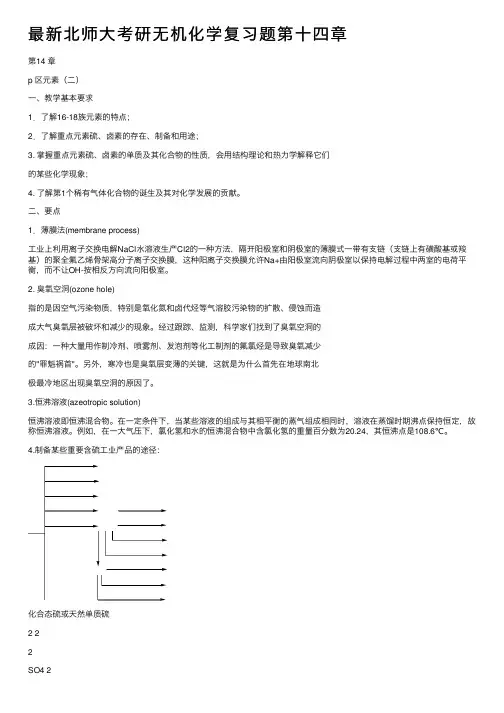
最新北师⼤考研⽆机化学复习题第⼗四章第14 章p 区元素(⼆)⼀、教学基本要求1.了解16-18族元素的特点;2.了解重点元素硫、卤素的存在、制备和⽤途;3. 掌握重点元素硫、卤素的单质及其化合物的性质,会⽤结构理论和热⼒学解释它们的某些化学现象;4. 了解第1个稀有⽓体化合物的诞⽣及其对化学发展的贡献。
⼆、要点1.薄膜法(membrane process)⼯业上利⽤离⼦交换电解NaCl⽔溶液⽣产Cl2的⼀种⽅法,隔开阳极室和阴极室的薄膜式⼀带有⽀链(⽀链上有磺酸基或羧基)的聚全氟⼄烯⾻架⾼分⼦离⼦交换膜,这种阳离⼦交换膜允许Na+由阳极室流向阴极室以保持电解过程中两室的电荷平衡,⽽不让OH-按相反⽅向流向阳极室。
2. 臭氧空洞(ozone hole)指的是因空⽓污染物质,特别是氧化氮和卤代烃等⽓溶胶污染物的扩散、侵蚀⽽造成⼤⽓臭氧层被破坏和减少的现象。
经过跟踪、监测,科学家们找到了臭氧空洞的成因:⼀种⼤量⽤作制冷剂、喷雾剂、发泡剂等化⼯制剂的氟氯烃是导致臭氧减少的"罪魁祸⾸"。
另外,寒冷也是臭氧层变薄的关键,这就是为什么⾸先在地球南北极最冷地区出现臭氧空洞的原因了。
3.恒沸溶液(azeotropic solution)恒沸溶液即恒沸混合物。
在⼀定条件下,当某些溶液的组成与其相平衡的蒸⽓组成相同时,溶液在蒸馏时期沸点保持恒定,故称恒沸溶液。
例如,在⼀⼤⽓压下,氯化氢和⽔的恒沸混合物中含氯化氢的重量百分数为20.24,其恒沸点是108.6℃。
4.制备某些重要含硫⼯业产品的途径:化合态硫或天然单质硫2 22SO4 2Cl23H3H 2SO4三、学⽣⾃测练习题1.是⾮题(判断下列各项叙述是否正确,对的在括号中填“√”,错的填“×”)1.1 所有卤素都有可变的氧化数。
( )1.2 实验室中⽤MnO2和任何浓度HCl作⽤,都可以制取氯⽓。
( )1.3 卤素单质的聚集状态、熔点、沸点都随原⼦序数增加⽽呈有规律变化,这是因为各卤素单质的分⼦间⼒有规律地增加的缘故。
![[实用参考]无机化学-碳族元素.ppt](https://uimg.taocdn.com/b8f4c5919ec3d5bbfc0a744d.webp)

第十四章 答案1. 金刚石中碳原子采取sp 3杂化,C 原子与C 原子之间以共价键结合形成原子晶体,∴金刚石的主要特征为高硬度,高熔点,高沸点,不导电。
石墨中碳原子采取sp 2杂化,一个C 原子与三个C 原子以共价键连接形成层状结构,每个C 原子上还有一个垂直于层状平面的p 轨道,这些p 轨道重叠形成离域π键,其p 电子离域在每一层上,另外层与层之间是分子间作用力,∴石墨是混合型晶体,它的主要特征为具有润滑性,导电性和导热性。
2. CO 与N 2物理性质相似之处:具有较低的熔点和沸点,具有相近的临界温度和临界压力:m.p. (℃) b.p. (℃) 临界压力(atm) 临界温度(℃)C O-200 -190 36-140 N 2 -210 -196 33-146 化学性质相似之处:CO 与N 2都不助燃;化学性质不同之处:CO 作还原剂,N 2的还原性很差;CO 可以作为配体,而N 2配位能力弱。
CO 与N 2分子性质之所以不同是因为,在CO 分子中O 原子上的一对电子占有C 原子的2p 轨道,增强了C 的电子密度,∴C 原子的配位能力强于N 2( )分子中的N 原子。
CO 2与N 2O 相似性很小,而差异性很大,显然它们并不是等电子体之故。
3. SiCl 4↑(1)Na 2SiO 3(2)←−−Si (3)−−→SiHCl 3 ↑(4)(5)4(6)←−−SiO 2(7)−−→Na 2SiO 3(8)−−→H 2SiO 3(1) Si + 2Cl (2) Si + 2NaOH + H 2O 2SiO 3 + 2H 2↑3 + H 2 (4) SiO 2 + 2Mg(5) 3SiF 4+ 4H 2O 4SiO 4 + 2H 2SiF 6 (6) SiO 2 + 4HF4 + 2H 2O(7) SiO 2 + Na 2CO 32SiO 3+ CO 2↑ (8) SiO 32- + 2H +2SiO 3↓4. SiO 2晶体属于原子晶体,基本单元为SiO 4,Si 原子为四面体中心,四个O 原子位于正四面体的顶点,原子之间以—O —Si —O —共价键相连,∴以固体状态存在;而CO 2是直线型分子,低温下固体CO 2属于分子晶体,每个CO 2分子通过分子间作用力连接,作用力很弱,温度略微上升,分子间作用力就被破坏而形成单个CO 2分子,∴常温时为气态。

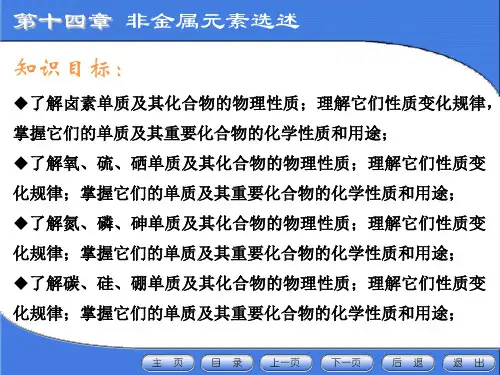
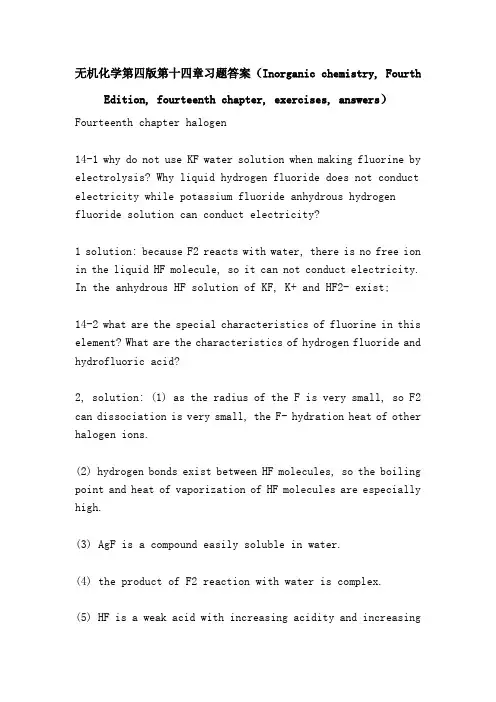
无机化学第四版第十四章习题答案(Inorganic chemistry, Fourth Edition, fourteenth chapter, exercises, answers)Fourteenth chapter halogen14-1 why do not use KF water solution when making fluorine by electrolysis? Why liquid hydrogen fluoride does not conduct electricity while potassium fluoride anhydrous hydrogen fluoride solution can conduct electricity?1 solution: because F2 reacts with water, there is no free ion in the liquid HF molecule, so it can not conduct electricity. In the anhydrous HF solution of KF, K+ and HF2- exist;14-2 what are the special characteristics of fluorine in this element? What are the characteristics of hydrogen fluoride and hydrofluoric acid?2, solution: (1) as the radius of the F is very small, so F2 can dissociation is very small, the F- hydration heat of other halogen ions.(2) hydrogen bonds exist between HF molecules, so the boiling point and heat of vaporization of HF molecules are especially high.(3) AgF is a compound easily soluble in water.(4) the product of F2 reaction with water is complex.(5) HF is a weak acid with increasing acidity and increasingconcentration.(6) HF can react with SiO2 or silicate to form gaseous SiF4;14-3 (1) the reaction tendency of Cl2 was generated by comparing KMnO4, K2Cr2O7 and MnO2 with hydrochloric acid (1mol.L-1) according to the electrode potential.(2) what is the minimum concentration of hydrochloric acid if MnO2 is reacted with hydrochloric acid to cause Cl2 to occur successfully?3, Xie: (1) according to the relationship between electrode potential, we can see the reaction trend:KMnO4>K2Cr2O7>MnO2;14-4 according to the potential map, the reaction equilibrium constant of Br2 in alkaline aqueous solution is reduced to Br- and BrO3- at 298K.4. Solution: by formula: -ZFE=-RTlnKGet: K=exp (ZFE/RT)=2.92 * 103814-5, three, fluorinated nitrogen NF3 (boiling point -129 degrees Celsius) does not show Lewis alkaline, and relatively low molecular mass compounds NH3 (boiling point -33 degrees Celsius) is a well known Lewis base. (a) to explain the reasonwhy their volatility is so great; (b) explain why they differ in alkalinity.5. Xie: (1) NH3 has a higher boiling point because of the hydrogen bond between the molecules.(2) the NF3 atom has a large radius of F atoms, which makes it difficult to match Lewis acid because of steric hindrance.In addition, the electronegativity of the F atom is larger, which weakens the electronegativity of the central atom N.14-6 from bittern making Br2 available chlorine oxidation method. But from a thermodynamic point of view, Br- can be oxidized to Br2 by O2. Why not use O2 to make Br2?14-7 pass Cl2 can be used in slaked lime to obtain bleaching powder, and hydrochloric acid can be added to Cl2 in the solution of bleaching powder. The two phenomena are explained by using electrode potential.7, Xie: because Cl2 pass into the hydrated lime is in alkaline medium, and because of, so Cl2 in alkaline conditions prone to disproportionation reaction.When the hydrochloric acid is added to the bleach solution, the following reaction can be carried to the right:HClO + Cl- + H+ = Cl2 + H2O14-8 which of the following oxides are anhydrides: OF2, Cl2O7,ClO2, Cl2O, Br2O and I2O5? If the anhydride is prepared, the reaction is obtained by the corresponding acid or other method of getting the anhydride.8 solution: Cl2O7 is the anhydride of HClO4. Cl2O, Br2O are HClO, HBrO anhydrides, respectively14-9 how do you identify the three salts of KClO, KClO3, and KClO4?9 、 solution: add a small amount of solid into the dried test tube, and then do the following experimentAdd dilute hydrochloric acid, that is, Cl2 gas release is KClO;KClO+2HCl=KCl+Cl2+H2OAdding concentrated hydrochloric acid has Cl2 and emits, and the solution turns yellow is KClO3;8KC1O3+24HCl (strong) =9Cl2 = +8KCl+60ClO2 (yellow) +12H2OThe other is KClO414-10 the reaction equation for preparing HIO4, KIO3, I2O5 and KIO4 was prepared with I2 as raw material.The solubility of 14-11 (1) I2 in water is very small. The concentration of I2 saturated solution is calculated from the following 2.5 reactions at 298K.I2 (s) + 2e- = 2I-; 0.535V = Phi thetaI2 (AQ) + 2e- = 2I-; 0.621V = Phi theta(2) 0.100mol I2 was dissolved in 1.00L 0.100mol.L-1 KI solution and I3- solution was obtained. The Kc value of the I3- generation reaction is 0.752, and the concentration of I2 in the I3- solution is calculated.14-11, (1) I2 (AQ) =I2 (s)K=exp (ZFE/RT)=812K=1/[I2 (AQ)]I2 (AQ) =1/812=0.00123mol/L(2) I2+I-=I3-;KC=; so [I2]=?The solution is x=0.0934mol/L.Explain the following phenomena: 14-12 by adding a small amount of NaClO in the electrode potential of starch potassium iodide solution, blue A solution, adding excessive NaClO, B get a colorless solution, then acidified and add a small amount of solid Na2SO3 in B solution, A blue reproduction, when the excessive amount of Na2SO3 blue and then faded become colorlesssolution C, A the solution then add NaIO3 solution and blue. Point out A, B, C why each kind of substance, and write out the reaction equation of each step.12, Xie: A:I2;B:NaIO3;C:NaI14-13 write out the equation for the reaction of iodate and excess H2O2, such as adding starch to the system. What do you see?13 solution: HIO3+3H2O2=3O2+HI+3H2O; if the starch is added to the system, the solution turns blue slowly and then fades.14-14 write out the molecular formula of three metal halides with covalent bonds, and explain the common properties of this type of halides.14 and Xie: (AlCl3) 2; (AlBr3) 2; (AlI3) 2; all molecules contain coordinate bonds14-15 what is a multi halide? What is the trend of the formation of Br3- and Cl3- ions in comparison with I3- ions?14-16 what are halogen compounds?(a) write ClF3, BrF3 and IF3 halogen halide complexes, central atom hybridization orbitals, molecular electronicconfigurations and molecular configurations.(b) is there any risk of explosion when the following compounds are exposed to BrF3? Explain why.SbF5; CH3OH; F2; S2Cl2(c) why are halogenated compounds often diamagnetic, covalent, and chemically active than halogen?14-17 laboratory has a calcium halide, soluble in water, try to use concentrated H2SO4 to determine the nature and name of this salt.17. Solution: different phenomena can be identified by the reaction of halide with concentrated sulfuric acid.14-18 please click the following example,The bromine, iodine, and halogen ions containing various conversion and transformation conditions as oxygen acid interaction diagram.。
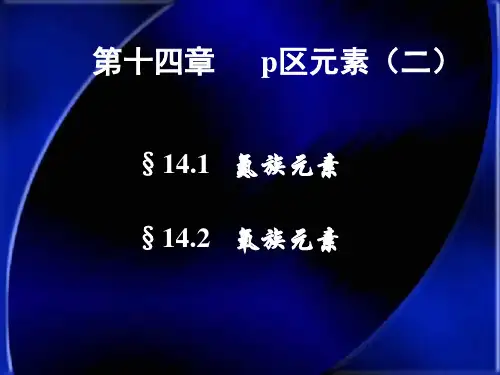
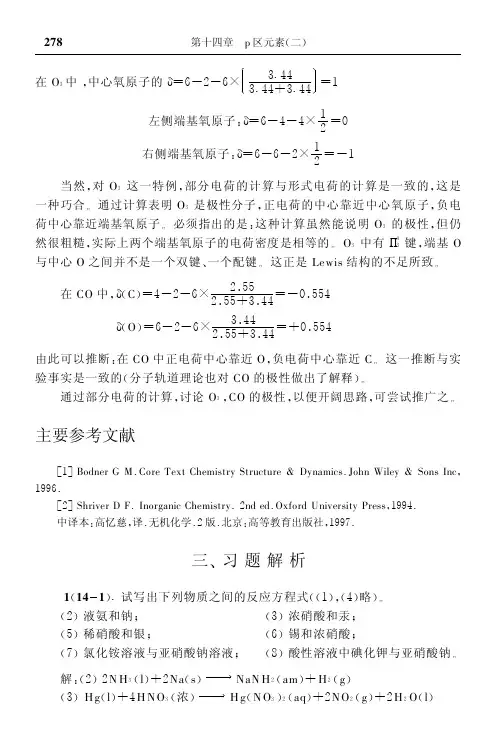
在O3中,中心氧原子的δ=6-2-6×3畅443畅44+3畅44=1左侧端基氧原子:δ=6-4-4×12=0右侧端基氧原子:δ=6-6-2×12=-1 当然,对O3这一特例,部分电荷的计算与形式电荷的计算是一致的,这是一种巧合。
通过计算表明O3是极性分子,正电荷的中心靠近中心氧原子,负电荷中心靠近端基氧原子。
必须指出的是:这种计算虽然能说明O3的极性,但仍然很粗糙,实际上两个端基氧原子的电荷密度是相等的。
O3中有Π43键,端基O 与中心O之间并不是一个双键、一个配键。
这正是Lewis结构的不足所致。
在CO中,δ(C)=4-2-6×2.552.55+3.44=-0.554δ(O)=6-2-6×3.442.55+3.44=+0.554由此可以推断:在CO中正电荷中心靠近O,负电荷中心靠近C。
这一推断与实验事实是一致的(分子轨道理论也对CO的极性做出了解释)。
通过部分电荷的计算,讨论O3,CO的极性,以便开阔思路,可尝试推广之。
主要参考文献 [1]Bodner G M.Core Text Chemistry Structure&Dynamics.John Wiley&Sons Inc,1996. [2]Shriver D F.Inorganic Chemistry.2nd ed.Oxford University Press,1994. 中译本:高忆慈,译.无机化学.2版.北京:高等教育出版社,1997.三、习题解析 1(141)畅试写出下列物质之间的反应方程式((1),(4)略)。
(2)液氨和钠; (3)浓硝酸和汞; (5)稀硝酸和银;(6)锡和浓硝酸; (7)氯化铵溶液与亚硝酸钠溶液;(8)酸性溶液中碘化钾与亚硝酸钠。
解:(2)2N H3(l)+2Na(s)NaN H2(am)+H2(g) (3)H g(l)+4H N O3(浓)H g(N O3)2(aq)+2N O2(g)+2H2O(l) (5)3Ag(s)+4H NO3(稀)3AgN O3(aq)+NO(g)+2H2O(l) (6)Sn(s)+4H N O3(浓)β-H2SnO3(s)+4N O2(g)+H2O(l) (7)N H4Cl(aq)+NaN O2(aq)△N2(g)+NaCl(aq)+2H2O(l) (8)2I-(aq)+2N O-2(aq)+4H+(aq)I2(aq)+2N O(g)+2H2O(l) 2(142)畅完成并配平下列反应方程式((1),(2)略): (3)Cu(N O3)2△(4)H g(N O3)2△ 解:(3)2Cu(N O3)2(s)△2CuO(s)+4NO2(g)+O2(g) (4)H g(N O3)2△H g(g)+2N O2(g)+O2(g) 樉熟悉硝酸盐受热分解的规律。
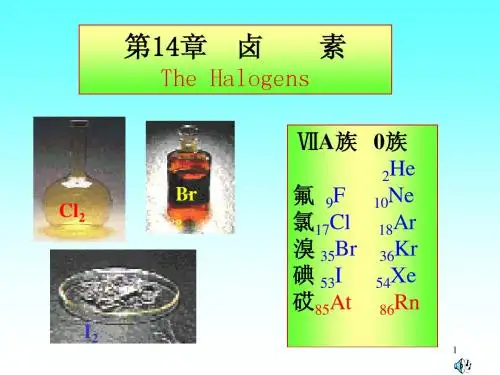
第14章 碳、硅、硼14.1. 对比等电子体CO 与N 2的分子结构及主要物理、化学性质。
解:CO 和N 2是等电子体(14e ),分子轨道能级图相似,分子中都有三重键:∶N ≡N ∶、C O δ+δ-∶∶,键能相近。
一般条件下,两种物质都是气体,很少溶于水;熔、沸点,临界压力,临界温度等一些物理性质也相似。
但CO 和N 2分子中三重键特点并不完全相同,N 2分子中负电荷分布是对称的,而CO 却是不对称的。
C 原子略带负电荷,再加上C 的电负性比N 小,因此CO 比N 2较易给出电子对向过渡金属原子(离子)配位,除形成σ―配键外,还有π―反馈键形成,故生成的配合物较稳定。
而N 2的配位能力远不如CO ,分子氮配合物远不如羰基化合物稳定。
所以CO 的键能虽比N 2略大,但化学性质却比N 2要活泼,不象N 2那样“惰性”。
14.2 概述CO 的实验室制法及收集方法,写出CO 与下列物质起反应的方程式并注明反应的条件:(1)Ni ;(2)CuCl ;(3)NaOH ;(4)H 2 ;(5)PdCl 2 解:CO 的实验室制法:HCOOH浓H 2SO 42O用排水集气法收集。
(1)Ni + 4CO100 -250atm 423 -493KNi(CO)4(2)(3)CO + NaOH HCOONa1.01×103kPa473K(4)CO + 3H 2CH 4 + H 2O Fe 、Co 、Ni523K,101kPa(5) CO + PdCl 2 + H 2O === Pd ↓ + CO 2 + 2HCl14.3. 某实验室备有CCl 4、干冰和泡沫灭火器(内为Al 2(SO 4)3和NaHCO 3),还有水源和砂。
若有下列失火情况,各宜用哪种方法灭火并说明理由: (1)金属镁着火; (2)金属钠着火;(3)黄磷着火; (4)油着火; (5)木器着火。
解:14.4. 标准状况时,CO 2的溶解度为170 mL / 100g 水:(1)计算在此条件下,溶液中H 2CO 3的实际浓度。
武汉大学版无机化学课后习题答案--14氮族元素第十四章 氮族元素1. 用MO 理论讨论N 2和NO 分子中的成键情况,并指出两者键级是多少? 答:N 2 :2222222*222pp p s s KK σππσσ 键级3 NO :1*22222222*222pp p p s s KK πσππσσ 键级2.5。
2.解释下列问题:(1)虽然氮的电负性比磷高,但是磷的化学性质比氮活泼?(2)为什么Bi(V)的氧化能力比同族其他元素强?答:(1) 氮的电负性比P 高,但氮不如P 活泼,这是由俩者单质的结构不同决定的。
N 的半径很小,但N 原子间形成三重键,叁键的键能很高,难以断开,因而N 2很不活泼。
P 原子半径很大,而使P 原子间的p 轨道重叠很小,不能形成多重键。
P-P 单键键能很小,很容易断开。
特别白磷的P-P-P 键角小张力大,更活泼。
(2) Bi(v)的氧化能力比同族其他元素强的多,出现了充满4f、5d,而4f、5d对电子的屏蔽作用较小,而6s具有较大的穿透能力,所以6s电子能级显著降低,不易失去,有“惰性电子对效应”。
失去2 个6s电子的Bi(v 更倾向于得到2个电子形成更稳定的Bi3+。
3.试从分子结构上比较NH3、HN3、N2H4和NH2OH等的酸碱性。
答:NH3结构见书648HN3结构见书658N2H4结构见书655NH2OH结构见书658得出酸性HN3> NH2OH > N2H4> NH3碱性相反。
4.试比较下列化合物的性质:(1)NO-3和NO-2的氧化性;(2)NO2、NO和N2O在空气中和O2反应的情况;(3)N2H4和NH2OH的还原性。
答:(1) 氧化性NO2->NO3-;(2) NO2不与空气反应;NO与空气在常温下即可反应,产生红棕色烟雾。
N2O也不与空气反应。
(3)还原性:N2H4 >NH2OH5.硝酸铵可以有下列两种热分解方式:NH4NO3(s)=NH3(g)+HNO3(g)ΔHθ=171kJ·mol-1NH4NO3(s)= N2O(g)+2 H2O(g) ΔHθ=-23 kJ·mol-1根据热力学的观点,硝酸铵固体按照哪一种方式分解的可能性较大。
无机化学第十四章-铅族元素
本文档将介绍无机化学第十四章中的铅族元素。
铅族元素是周期表中的第14族元素,包括铅(Pb)、锡(Sn)、锗(Ge)、硅(Si)、砷(As)和锑(Sb)。
铅(Pb)
铅是铅族元素中最常见的成员之一。
它是一种重金属,具有较高的密度和良好的延展性。
铅被广泛用于电池、管道、防辐射材料等应用中。
然而,铅也是一种有毒物质,在过量暴露下可能对人类健康产生负面影响。
锡(Sn)
锡是另一个重要的铅族元素。
它是一种延展性较好的金属,常用于制造锡箔、合金和焊接材料等。
锡也被广泛应用于食品罐头的镀锡过程中。
锗(Ge)
锗是一种具有半导体性质的铅族元素。
它在电子技术领域中发
挥着重要作用,常用于制造二极管、太阳能电池等。
硅(Si)
硅是铅族元素中最广泛应用的成员。
它是一种常见的半导体材料,被广泛用于电子器件的制造中。
硅还可以制成玻璃和陶瓷材料。
砷(As)
砷是一种具有毒性的铅族元素。
它广泛存在于自然界中,但在
大量暴露下对健康有害。
砷也有一些重要的应用领域,如制造农药
和防腐剂等。
锑(Sb)
锑是一种具有金属和非金属特性的铅族元素。
它常用于制造阻
燃材料、半导体器件和合金等。
以上是无机化学第十四章-铅族元素的简单介绍。
铅族元素在工业和科学领域中有着重要的应用,但我们也要注意它们的潜在危害和环境影响。
第十四章氮族元素知识点归纳一、氮的单质单质氮在常况下是一种无色无味的气体,在标准状况下密度为1.25g/dm3。
工业上生产氮一般是由分馏液态空气在15.2MPa压力下装入钢瓶备用,或做成液氮存在于液瓶中,实验室中制备少量氮气。
N2分子是已知的双原子分子中最稳定的.在高温高压并有催化剂存在的条件下,氮气可以和氢气反应生成氨:二、氦的成键特征N原子价最子层结构为2s2p3,即有3个成单电子和一个孤电子对,在形成化合物时,其成键特征如下:(1)形成离子键N原子有较高的电负性,它同电负性较低的金属形成一些二元氮化物即能够获得部分负电荷而形成N3-离子。
(2)形成共价键N电子同电负性较高的非金属形成化合物时它总是以不同的共价键同其他原子相结合,这些共价键一般有以下几种:三、氮的氢化物1.氨(1)氨的制备氨是氮的最重要化合物之一,在工业上氨的制备是用氮气和氢气在高温高压和催化剂存在下合成的:(2)氨分子的结构在NH3中,氨采取不等性sp3杂化,有一对孤电子对,分子呈三角锥形结构,键角为107。
18’。
这种结构使得NH3分子有较强的极性。
(3)氨的物理性质和化学性质NH3具有相对高的凝固点、溶解热、蒸发热、溶解度和介电常数,氨极易溶于水。
在水中的溶解度比任何气体都大,237K时1 dm3的水能溶解1200dm3的氨。
氨的主要化学性质有:①还原性KH3和NH4+离子中N的氧化价为+3,因此它们在一定条件下只能有失去电子的倾向而显还原性。
常温下,氨在水溶液中能被Cl2,H2O2,KMnO4等氧化。
例如:③加合反应氨中氮原子上的孤电子对能与其他离子或分子形成配位键,结果形成了各种形式的氨合物,氨能与许多金属离子形成氨配合物如[Ag(NH3)2]+。
④弱碱性氨极易溶于水,它在水中主要是形成水合分子,同时在水中只有一部分水合氨分子发生电离作用。
NH3·H2O的K b=1.8×10—5,可与酸发生中和反应.(4)铵盐氨和酸作用可得到相应的铵盐,铵盐一般是无色晶体,易溶于水,而且是强电解质。